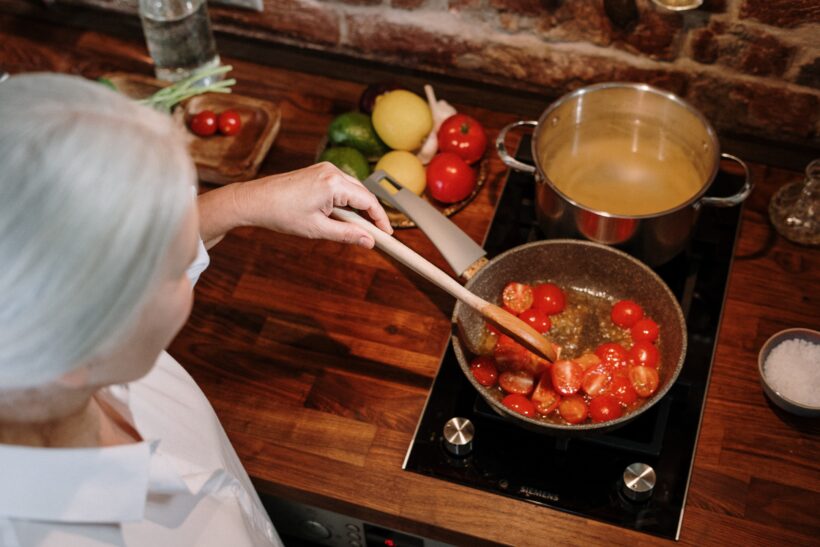 By DR. MIRIAM ACZEL
By DR. MIRIAM ACZEL
Induction cooking, a relatively new technology powered by electricity, is cleaner and more energy-efficient than cooking with gas or even traditional electric burners. Many cities throughout California are passing regulations banning natural gas use in new buildings. This means that residences and businesses—including restaurants—will need to switch from gas to induction cooking.
How does induction cooking work?
When you turn on an induction cooktop, you create a magnetic field all around and above the stove surface, which directly penetrates the cookware and heats it over 25–50 percent faster than either gas or traditional electric cooktops. Since energy is supplied directly to the cookware rather than the stove’s burners, induction cooking is 90–95 percent more efficient compared to gas, which releases up to two-thirds of the energy used and heats the kitchen. Induction is more efficient than a traditional electrical cooktop in which heat is generated in a coil (also known as a ring or burner) that is located beneath a ceramic cover over which the pan is placed. The greater the distance between the heat source—the coil below the ceramic surface—and the cookware, the greater the energy loss. Additionally, electric cooktops require greater amounts of energy to raise the temperature of the coil and are therefore both slower and less efficient to cook with.
Cooking with induction
There are a few tips that can help you take advantage of induction cooking. First, as the induction cooktop heats very quickly, have all your ingredients ready before you begin cooking. You won’t have time to chop and mix the food as there is no “wait time.”
Since induction cooking works by creating a magnetic current, you can’t use pans that are made of glass or have aluminum or copper bottoms. But you don’t have to buy special cookware—you can use steel, stainless steel, or cast iron pans, with heavier and/or thicker models providing better heating.
So what are the downsides to induction cooktops? It’s worth noting that induction cooktops can produce minimal noise from their built-in cooling fans. They also generate radio-frequency interference, which may pose a very small risk for those wearing heart pacemakers—but this risk is no greater than that posed by everyday electrical equipment.
Cutting kitchen carbon emissions
A significant portion of carbon emissions comes from natural gas combustion in buildings. In 2017, the City of Oakland found that over one-fourth of the city’s total emissions came from buildings, of which over 70 percent came from burning natural gas. This is because natural gas is primarily composed of methane, a greenhouse gas roughly 85 percent more potent than carbon dioxide. Recently, over 30 cities in California, including Oakland, Berkeley, and San Francisco, have banned natural gas in newly constructed buildings in an effort to cut greenhouse gas emissions. The City of Oakland is currently in the process of phasing out natural gas use in buildings for a variety of reasons, including lowering carbon emissions, reducing potential exposure to harmful chemicals, and public safety concerns posed by potential gas leakage.
Chefs weigh in—induction or not induction?
It is well known that chefs are masters of cooking on gas ranges—and from experience, they know how to gauge the temperature simply by looking at the flame. However, many professional chefs have started using induction cooktops in their restaurants and home kitchens. Induction cooktops are rapidly gaining in popularity as they are energy-efficient, easy to clean, and heat and cool quickly. Many chefs have reported that they love induction cooking because of its quick heating ability and precise temperature control. Since induction technology heats just the pan rather than the whole area around the stove, little heat escapes—and the kitchen stays comfortably cool. Australian chef Neil Perry, an early adopter of induction, says it’s “much faster to cook with induction: you can increase or drop the temperature far more quickly, which is a more efficient use of energy. Cutting energy use, when you don’t need it, makes a huge difference in a commercial kitchen.” The high efficiency of induction cooking compared to gas—or even electric energy—means making the switch can keep kitchens cooler, safer and cut energy costs.
Engaging local chefs and the community
A few months ago, East Bay Community Energy (EBCE) decided to engage local chefs willing to test out induction cooking and film them using the technology. EBCE reached out to Chef Reem Assil, owner of Reem’s California and a restaurateur dedicated to positively impacting the environment and her community. As Reem’s is dedicated to “community building, social justice, and sustainability,” EBCE is optimistic that the experience with induction would introduce the local restaurant community to the “benefits of a high-powered, magnetic technology that will change the face of cooking.”
You can watch Chef Reem’s induction cooking challenge video, where she cooks flatbread and shakshuka (eggs poached in a fragrant, spicy tomato-based sauce).
Cover image: Pexels
Editor’s note: this article originally appeared on the EcoBlock blog
Dr. Miriam Aczel is Leaders in Energy’s Director of Scientific Communications. Miriam is a postdoctoral scholar at the California Institute for Energy & Environment (CIEE) based at UC Berkeley, working on the Oakland Ecoblock project. She is also currently an Honorary Research Associate at Imperial College London’s Centre for Environmental Policy, with a focus on international energy science and policy, with a focus on mitigation of environmental and health impacts of shale gas. Miriam earned her PhD at Imperial College London in 2020, where she was a President’s PhD Scholar. She is also co-founder and co-director of the Amir D. Aczel Foundation for Research and Education in Science and Mathematics, a nonprofit based in Cambodia.



Leave a Reply